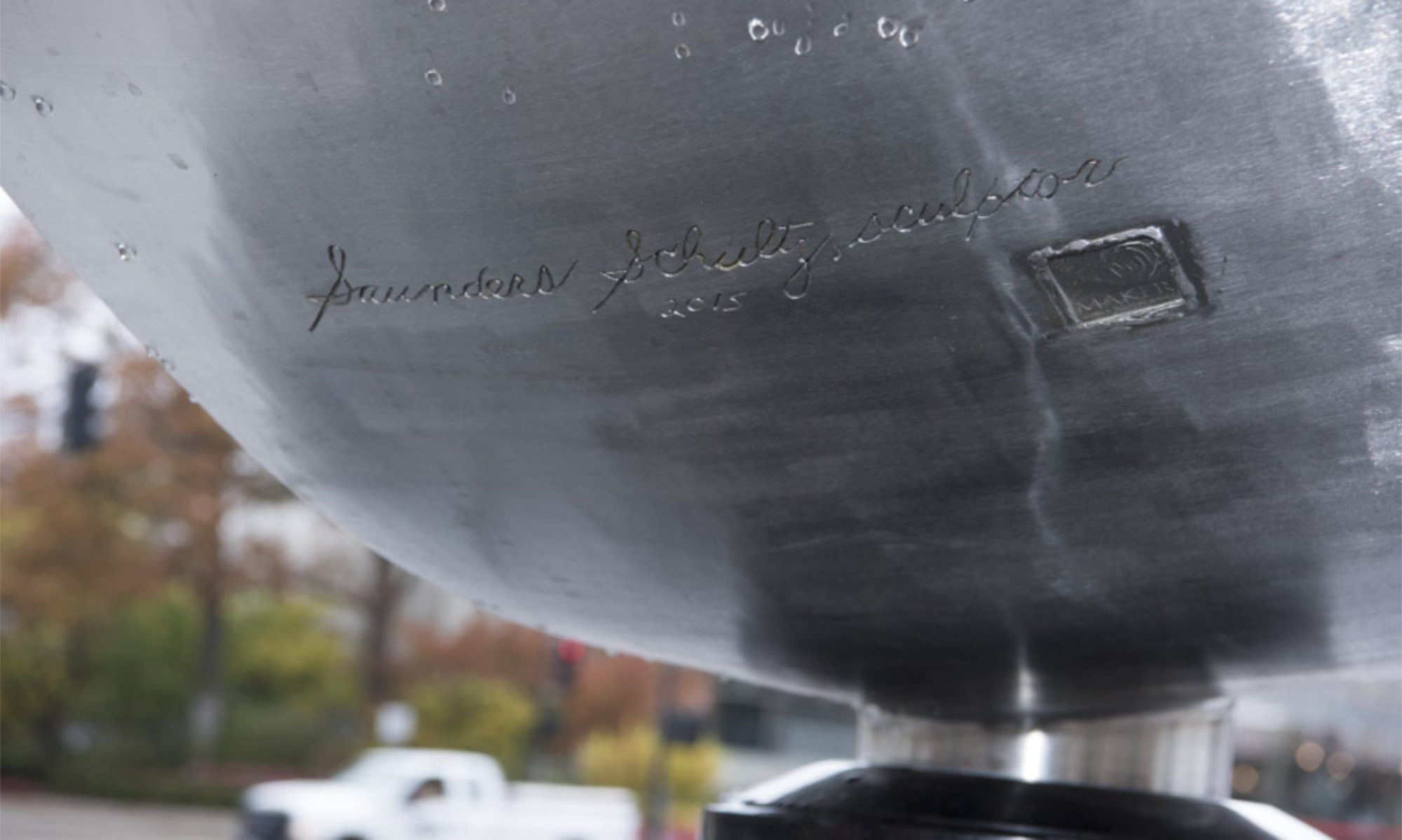The Eco Arch is a living museum of earth and spirit destined to fulfill five realities vital to any improvement of the Mississippi River as the centerpiece of the St. Louis region. These five realities deal with ecological and economical justice, correct siting, respect for history and atonement to the land, and symbolic location.
First, the Eco Arch will be linked with its host city of East St. Louis in popular imagination just as the Arch says St. Louis to the world. It combines in its name ecology and economy because it foretells a new reality. Several architects who worked for Eero Saarinen said that the Arch represented to him technology's triumph over nature. The Eco Arch comes full-circle where humankind and nature coexist in harmony and balance. It will become an effective engine for economic recovery on the East side. East St. Louis must become a full partner in this riverside renaissance.
Second, the Eco Arch will beautify and correctly develop the area along the eastern riverfront in axial proportion and scale to Saarinen's existing monument. In this way, the Mississippi river will cease to cut the two cities apart and unite St. Louis with East St. Louis at long last. This feat will be accomplished on a monumental scale equaling that of the Arch and Cahokia. The shape must relate to and incorporate the exact weighted catenary parabolic form chosen by Eero Saarinen. The Eco Arch's parabolic form will provide an elegant geometric standard to guide future development of the larger site, and insure that the view from the west will be as striking as the view to the west. At its base, a fountain will fill in the Arch across the river with ever changing patterns when viewed from the vast green amphitheater lawn.
Third, the Eco Arch will draw attention to the prehistoric culture of our region and support the educational vision of nearby Cahokia, a World Heritage site. By paying homage to Native American achievements, the Eco Arch will reconnect local residents and visitors to the great civilization of the Mound Builders. The huge building beneath the landscaped public gathering place will house a national museum of Native American culture where ancient dwellings, earthen berms and interpreted archaeological excavations can be dramatically replicated. Within these structures, narrative displays and artifacts will illuminate the magnificent achievements and the ultimate sacrifices of Native American Tribes. Other elements also contained in the vast structure, will honor the strong existing vital African American musical and cultural heritage of East St. Louis.
Fourth, the Eco Arch will one day become one of our country's most significant monuments of rightful atonement to the peoples and cultures who called this land "home" before the arrival of the Europeans. Katherine Dunham’s letter in support of the Eco Arch:
"It is especially meaningful to me that your proposal honors the early
inhabitants with its strong connection to Cahokia. After all, these
ancestors chose this environment as their special place. Buckminister
Fuller told me, ' "East Saint Louis will never thrive until we make peace
with the thousands of dead Native Americans buried from East St. Louis to
Cahokia. Your Eco Arch honors these women and men in a monumental
visionary manner.”
Finally, the Indian Removal Act banished tribes to the western side
of the Mississippi river where the Gateway Arch now stands. So why St. Louis?
This Eco Arch, a Native American monument and educational component, located on the eastern bank of the river will symbolize a spiritual return from exile
Why is this museum devoted to honor, respect and atonement of the Native American culture and the land, so appropriate at our “Gateway to the West”? It was here that we continued west to take the land, freedom, dignity and in far too many cases, the lives of our “First Americans” In return we gave them grief and heartache. Isn’t it time for us as a nation to return to the ‘Gateway’ to create this monumental, long overdue tribute?
I hereby give you the name, "SAUNDERS BRAVES THE STORM"
Chief Ivan Ivan
Eastern Oklahoma Region
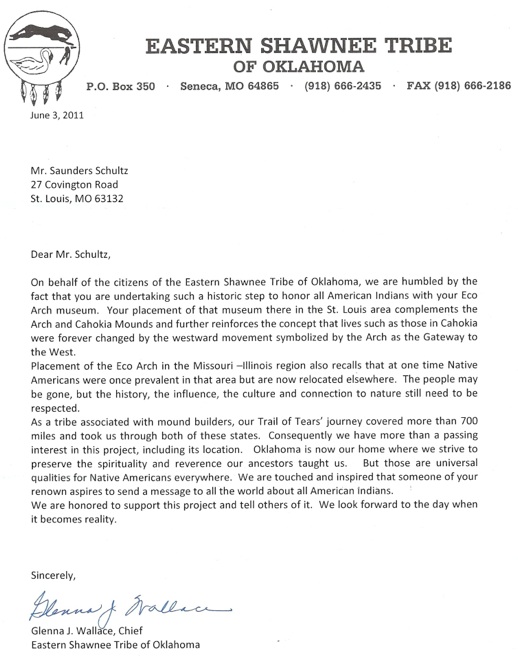

Mark Esarey , Site Manager at Cahokia Mounds, a World Heritage Site, suggested I call Dr. Molly Tovar.
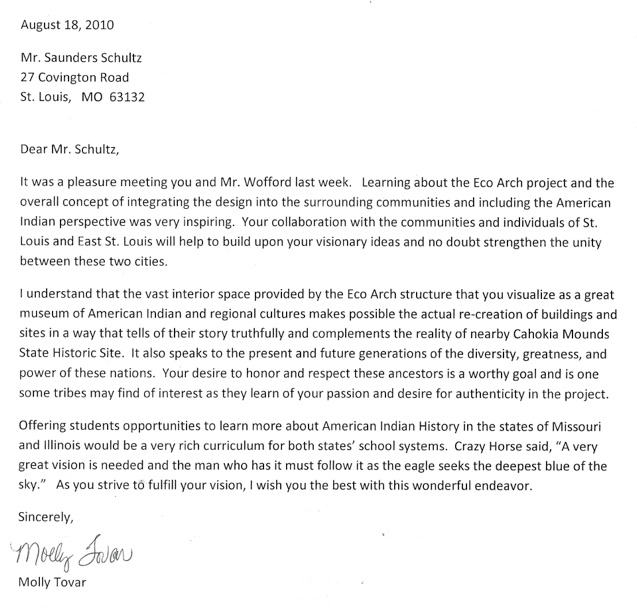
Dr. Molly Tovar, of American Indian (Comanche) decent, is the director of the Kathryn M. Buder Center for American Indian Studies at Washington University. She holds a Ph. D. in Higher Education and Administration from Oklahoma State University at Stillwater, and received the Outstanding Oklahoma Native AmericanLeadership Award. From 2001 to 2006 she worked with the Bill and Melinda Gates Millennium Scholar Program for the American Indian-Alaska native.





William Harjo
Flutist/Flute Maker
Traditional Story Teller
202 Gary Court
Livingston, Texas, 77351

Dear Saunders, August 29, 2011
In response to the Native American segment of your Eco Arch proposal:
As American Indians we don't expect restitution for all that was taken from our ancestors, but I would like the truth to be told in our history books for all their descendants. The people of America need to know the true history as well.
It should be noted that as an example of truth-telling, the Muskogee Creek nation’s homelands were in Georgia, Northern Florida and Alabama until they were relocated by force into Oklahoma by Andrew Jackson in early 1800. This was the beginning of the Trail of Tears.
William Harjo
Muskogee Creek Tribe, enrollment # 29247
Okmulgee, Oklahoma
Full-blooded Creek Indian
Flutes exhibited in Smithsonian Institute

Eastern Region

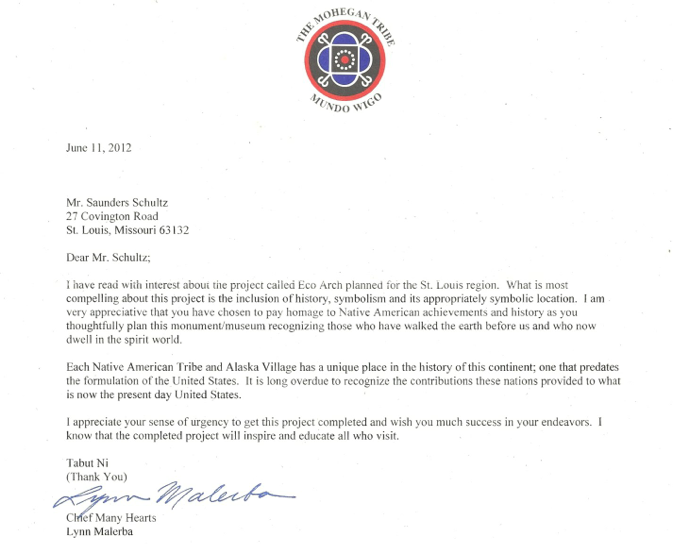



AROOSTOOK BAND OF MICMACS
PRESQUE ISLE, MAINE
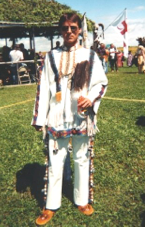
Dear Mr. Saunders:
I am Rick Getchell Chief of the Micmac Tribe in Northern Maine; I would like to thank you for your vision to honor Native Americans with your Eco Arch project. Often, Native struggles go UN seen and our history is never truly documented in its factual state. Rather history is written by the winners and leaves out the struggles and injustices of the past.
The Aroostook Band of Micmac’s support and honor what you are doing to recognize our history and our people. We wish you all the luck in carrying out your mission in getting your vision completed. We believe in the power and significance of your Eco Arch monumental project. Emsit No’Kamaq* With honor and respect,
*In Micmac, means “All My Relations” and is said in great honor after any ceremonies, fasts, sweat lodges or prayers in honor of present and past elders, and all people of Mother Earth.






Great Plaines Region


Midwest Region


Lac du Flambeau Band of Lake Superior Chippewa Indians
Lac du Flambeau, WI
Saunders, My name is Brooks Big John and I am a Tribal Council Member, and if there is any way I can be helpful to your endeavors ….do not hesitate to contact me. I was asked by our Chairman Tom Maulson to reach-out to you and offer our Tribes support in your efforts to establish the theme “that art must be monumental and fit the environment”. Tribes throughout Indian Country have always been stewards of the environment and have taken great measures to promote and protect the environment.
We support your idea that art must relate to the natural world and appreciate your proposed Eco Arch sculpture and education center in the St. Louis area…..what a great way to inform and share
Brooks Big John
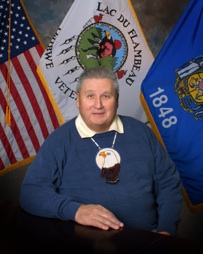
Northwest Region


Pacific Region


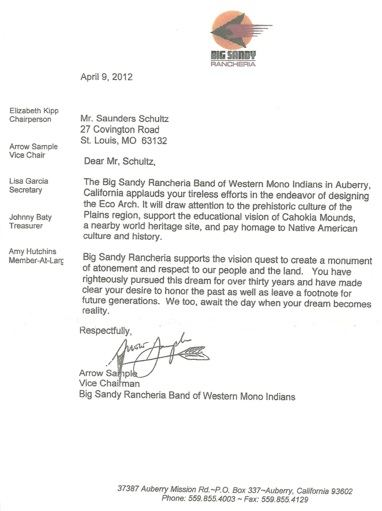
Rocky Mountain Region

Southern Plains Region


Sean Kirkland
May 3 2012
4152 Botanical Ave
St Louis MO, 63110
Dear Saunders,
My grandmother always told me that one of the most important traditions of the American Indian culture was storytelling. It is through stories that we pass on the wisdom of our ancestors and remember the incredible events our people have experienced. Through stories we attempt to understand who we are and where we came from. But stories will die unless they are written or told and passed through to each generation. So how do we preserve this important piece of our heritage? Some tribes create paintings and beadwork. Others tribes choreograph dances and write songs.
You Saunders, have a special gift of telling stories with elements that will remain with the earth and outlast generation after generation. Through your beautiful sculptures all around the world, you have been telling the story of our people long before you were even aware that you were doing so. It was only recently that the Great Creator has begun to reveal to you that you were telling our story through steel, wood, bronze and marble.
Your legacy is that of which will not disappear or vanish into the wind. These pieces will be around for hundreds of years for children to look upon and touch. I am amazed at your mastery of these elements and your ability to shape these things of the earth into stories of nature and people. I know that it is your last dream to pay tribute to the Native American people who lived in these lands long ago by creating the Eco Arch. The road to its construction is a difficult one but I fully support you in your quest to unite the support of different tribes to see its full development. I am inspired by your voice and honored to be your friend. Thank you for being one of the most courageous story tellers of our time.
Your friend,
Sean Kirkland
Comanche Tribal member


Southwest Region
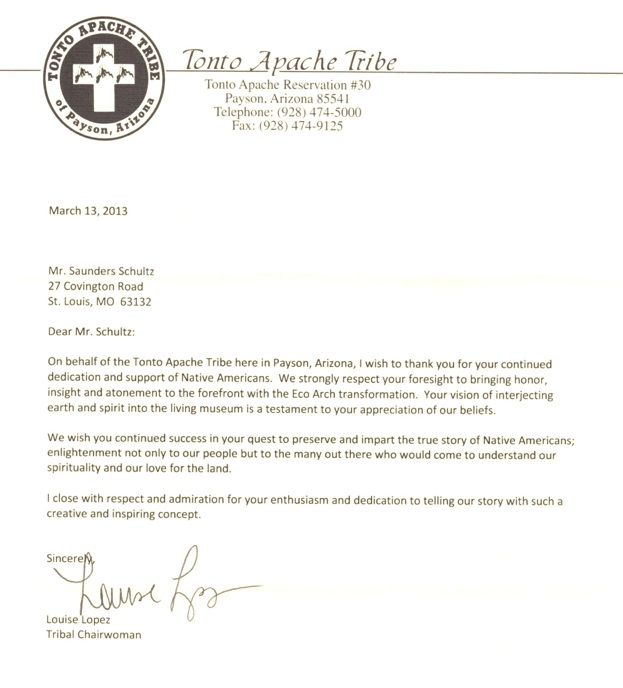
Western Region
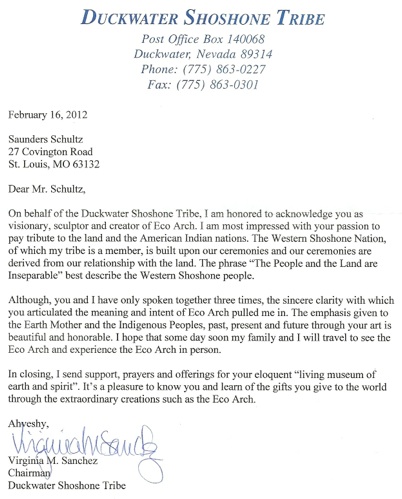
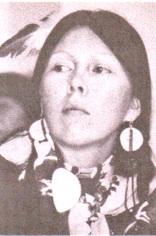
Alaska Region
While Alaska is the most distant place from the St. Louis riverfront, the warmth of its people's support is unique and deeply appreciated. Their words come at the end of this section to symbolize a strong conclusion.


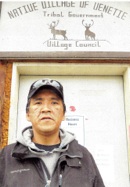

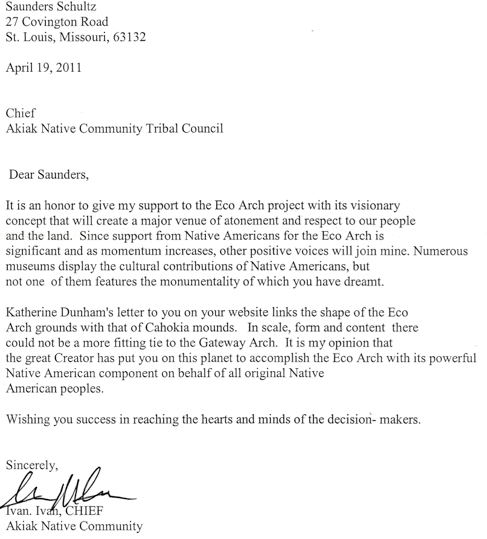

The American Indian had no word for art and believed that a beautifully made object was “a prayer made visible.”
J. Rezendes - Letters to the Editor- New York Times, 12 / 7 / 86
Projects Inspired by Native American Thought and Culture
In 1982, Anheuser Busch Brewery was searching for a dramatic symbol to help anchor their presence in the Columbus, Ohio community. A fountain/sundial called HORA NOVEM was designed. The architect was Thomas Ventulett with Robert Goetz, the landscape architect.
HORA NOVEM interacts with the sun to pinpoint noon, the months of the year and the autumnal and vernal equinoxes. Water jets along the entire inner surface, creating constant rainbows.
A quote from the Oglala Lakota Sioux Tribe medicine man, visionary, Black Elk, (1863-1950) sums up what HORA NOVEM symbolizes:
“The power of the world always works in circles, and everything tries to be round. Even the seasons form a great circle in their changing, and always come back again to where they were.”





"Humankind has not woven the web of life. We are but one thread within it.Whatever we do to the web, we do to ourselves. All things are bound together.All things connect."
Chief Seattle
“All things in the world are two. In our minds we are two, good and evil. With our eyes we see two things, things that are fair and things that are ugly…We have the right hand that strikes and makes for evil and we have the left hand full of kindness, near the heart. So we are all things two, all two.”
Letakos Lesa, Pawnee Eagle Chief




RESPECT FOR THE EARTH. Everything that is comes from the Earth. And you must not forget that you come from the earth as well. When working with clay, you must listen to the earth, and the clay will speak to you, and you must simply let the clay guide the shape your work. The clay is alive. The clay will guide your hands. You must never go against the will of the clay, which is ultimately the will of the Earth, and the path to happiness.This is a belief that is kept alive by the 26-tribal colleges.



This forward-looking 1954 two story sculptural relief draws its inspiration from the spirit of the American Indian sense of the New Mexico natural environment as well as colors of Navajo weavings. My palette consisted of orange for the sun, brown and tan for the terrain, blue for the sky- all against the background symbolizing clouds, white sand deserts and snowy peaks. Monumental triangles across the facade recall the state’s vast and rugged expanse. It became a landmark at the four corner section of the southwest, with the state boundaries of Arizona, New Mexico, Colorado, and Utah.



Treat the earth well: it was not given to you by your parents,
it was loaned to you by your children. We do not inherit the
Earth from our Ancestors, we borrow it from our Children.
Ancient Native American Proverb

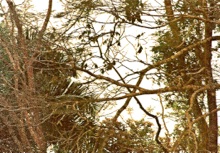

“We must protect the forests for our children,
grand children and children yet to be born.
We must protect the forests for those who
can't speak for themselves such as the
birds, fish and trees.”
Qwatsinas ( Hereditary Chief Edward Moody),
Nuxalk Nation
“We learned to be patient observers like the owl.
We learned cleverness from the crow, and the
courage from the jay, who will attack an owl
ten times its size to drive it off its territory.
But above all of them ranked the chickadee
because of its indomitable spirit.”
Tom Brown, Jr. The Tracker

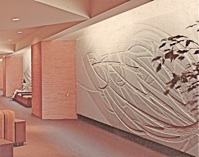

“From Wakan-Tanks, the Great Mystery, comes all power.
It is from him that the holy man has wisdom and
the power to heal and make holy charms. Man
knows that all healing plants are given by Wakan-Tanks,
therefore they are holy.”
Flat-Iron -- Maza Blaska Oglal, Sioux Chief






